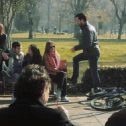"Man with the virtual movie camera: Alex Roman's short film masterpiece provides a voyage across architecture art through the eyes of a photographer."
Editing & Continuity
At an average shot length of 4.2 seconds, editing pace is slightly slower than current filmmaking averages and uses mostly cuts, with just a few fades. The slow-paced camera moves and visual rhythm allow for straight cutting without unpleasant jumps. Continuity is explicitly broken in a few sequences, jump cuts are used in these cases to speed up rhythm, such as the ones that show a camera along the title of the film (1m22).
Editing is used in other sequences to build up momentum, moving from close-up shots to wide ones, or to construct relationship/meaning, as the ones with the windmills moving and the bits of grass/wheat floating in the air. Montage within the frame is used in some sequences, splitting the image and modifying rhythm.
Continuity is supported by the accompanying music. There is no evolving narrative but there are a number of progressions that take place throughout the short (see “Story” section below).
The world constructed by the film is composed of buildings in urban settings and a progression towards natural landscapes. The time of the day changes throughout the film. Some sequences are spent indoors with artificial light, and a few shots are dedicated to evening/night time, but most shots take place during daytime. There is no clear definition of the amount of days passing or lack of it. The film, however, has a certain feeling of timelessness to it, due to the combination of old and modern elements, the emphasis on nature and the introduction of the surreal.
TT&TS also puts the camera (in this case cameras) at the center of the film, showing the purported means of production of the shots. Of course, no real cameras took part in it, as 99% of it is 3D animation (exceptions include the photographer, pigeons, timelapsed growing flowers, flying airplane and sky backgrounds).
The weather is another factor that varies and is strongly present towards the end of the film, helping define aesthetics and mood.
Image & Iconography
Here we find more important keys to understanding how the short functions with the audience. The obvious one goes first, every shot is a work of art. Words can’t do them justice. Suffice to say that this is a compilation, an immersed voyage of 12 minutes of amazing art. This helps understand the emotional impact it has on the viewer.
Second, the shots portrayed are usually partially occluded, hinted, out of focus, revealed through time. Only wide shots are usually explicit. In most other cases the viewer is called to participate, trying to catch glimpses of what is being shown. This aesthetic of insinuation or allusion is repeated in the case of the photographer (the author himself), who is first shown behind a glass material. We see his shadow a number of times, until he is revealed towards the end.
Third, TT&TS is literally filled with sensory images that appeal to the senses. From the materiality of objects, surfaces and sounds, to the way light flashes in and out of shots, to the tangible presence of nature through water, grass, leaves blowing in the wind and stormy skies. TT&TS is alive, it can be sensed and breathed.
Finally, the jump to a surrealist discourse through the introduction of non-realistic elements towards the half of the short frees it from the realistic portrayal and elevates it to the poetic realm, complementing well the aesthetic of allusion and the increasing references to nature.
Story
No story, no conflict. At least in the traditional sense. But at this point one can understand why the short film works perfectly well without them. TT&TS is above everything else an aesthetic exploration that fills the senses, a study of materials and surfaces, of light and shadows, of architecture, space, time, composition and movement. The photographer and cameras are used as narrative devices to provide continuity and weave the various sections together.
It should be mentioned that the fact that these studies of reality have been produced with 3D software is an interesting fact in itself (and a testament to how much the computer graphics field has advanced in just a few decades).
Even if it has no evolving story in the standard sense, TT&TS presents a number of progressions throughout the 12+ minutes, such as the move from urban to nature, shifts in time, the change in weather from sunny to stormy, the move from a realistic to a surreal aesthetic, the mystery of the photographer that is revealed towards the end, and several sequences where there’s a progression from the particular to the general.





















Watching this short film was the best visual experience of my life.i loved it. I was carried away in world of colors , objects ,different angels ,architecture, nature…
It is all like living in a dream!! Wonderful work of art!!
I liked the movie and the report very much. Good job!!!!!